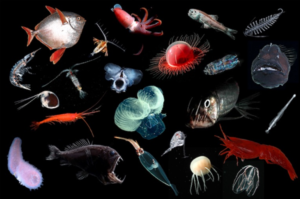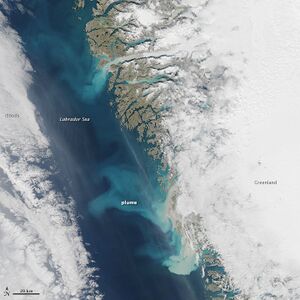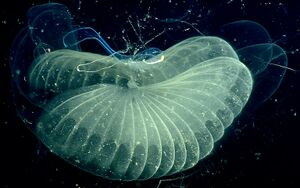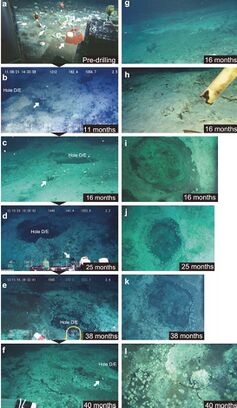Course:EOSC270/2021/Under the Sea: the issue with Deep-Sea Mining
What is the problem?
Deep Sea mining generates sediment plumes
The Earth’s ocean floor is a mystical home to an enormous variety of life that supports the functioning niche of the marine ecosystem. However, the critical ocean ecosystem is threatened by sediment plumes that are generated from deep-sea mining[1]. Deep sea mining is the process of extracting mineral deposits, like copper and nickel, from the seafloor. In order to retrieve these materials, robotic-like machines travel along the ocean floor to collect the mineral deposits, which are then transported to the surface by hydraulic pumps to be processed. During the mining process, the motion of machines excavating the seafloor creates sediment disturbances and turbidity in the water column [2]. The upheaval of bottom sediments combined with the increased water turbidity generates what is termed as a "sediment plume." Sediment plumes can cause devastating effects to the marine ecosystem, as well as the organisms that live there. Possible effects of sediment plumes include, benthic habitat destruction, changes in the water column, and a decrease in biodiversity.

Mineral exploration activities enforce sediment plumes
The high demand of minerals such as manganese and cobalt by industries that promote electronics, batteries, and fertilizers is the key human activity that leads to the scraping of the ocean floor hence generating sediment plumes. Humans target the ocean floor for the retrieval of minerals because there are various valuable rare-earth metals that are embedded profoundly in the sea floor [3]. Furthermore, humans have a growing interest in deep sea mining because there is an exhaustion of these minerals in terrestrial environments. Therefore, the deep sea is targeted for mineral exploration activities where the extraction of resourceful minerals is enforcing sediment plumes to extensively influence the flora and fauna of the deep sea.

Where do sediment plumes occur?
Sediment plumes will initially occur on the seabed, at the source of mining site. However, it can also occur at the sea surface. The plumes which are created at the seabed from mining techniques are known as near bottom plumes and those generated through transportation at the sea surface are near surface plumes [4]. The sediment plumes created are a mixture of dissolved material and suspended particles that are of various sizes. Usually, the plumes containing larger particles at the sea-bed accumulate on the ocean floor while the dissolved material travels across the sea-bed to greater distances[5]. The near-surface plumes will usually have particles accumulating at the sea surface and thus blocking sunlight for a range of photosynthetic organisms[4]. Sediments plumes at both locations can transport to greater distances due to unpredictable ocean currents and turbulence. Hence, these plumes cause extensive damages to a range of sea organisms and the underwater topographical features.
Are sediment plumes currently pervasive?
Despite the catastrophe that sediment plumes can bring to a multitude of marine species, this issue is not currently pervasive. Although it is not pervasive, it is an alarming problem to many marine biologists and environmentalists because it can become a much greater issue in the future as terrestrial resources and minerals continue to deplete [6]. Deep sea mining is not currently in use, but numerous studies are still being conducted to determine how far sediment plumes can travel in the oceans. There are also ongoing studies on other potential threats such as respiratory distress and reduced feeding behaviours caused by sediment plumes.
How does this problem impact marine ecosystems?
How does Deep Sea Mining Impact Marine Ecosystems?

In mining practices, suspension plumes are created during two processes, the action of mining equipment scraping the ocean floor, and the transport of mined materials [4]. These two processes generate two types of plumes: bottom plumes and near surface plumes, which affect different aspects of the marine ecosystem [4].
Bottom plumes greatly impact the benthic ecosystem of the deep sea by directly disrupting fragile seabed habitat [4]. The benthic ecosystem is unique in that it is vastly unknown, with an estimate of only 5-10% of the seafloor being mapped [7]. However, it is also estimated that no oceanic region is completely untouched by human impact, it is just the extent to which these communities are impacted that is unknown [7]. This makes the sea floor vulnerable to deep-sea mining, as we lack fundamental knowledge on ecosystem processes and function, and how mining practices will disrupt them.
Near surface plumes impact the pelagic community by increasing the turbidity in the water column, as well as increasing sedimentation rates in the surrounding regions [8]. The effects of surface plumes are arguably more devastating as suspended matter has the ability to not only remain in the water for long periods of time, but also travel laterally with ocean currents [8]. Increased water turbidity can also alter biological productivity, by allowing bottom nutrient rich sediments to rise to the surface, which can create artificial upwellings, or on the flip side, decrease light availability to photosynthetic organisms, and reduce rates of photosynthesis [9].

How does this impact Organisms?

Sediment plumes impact multiple different classes of organisms.
In the benthic environment, sea-floor dwelling organisms face not only habitat destruction, but mortality via smothering or burial [9]. Additionally, particles suspended during mining not only contain toxic metals, but also clog the filter feeding apparatus of benthopelagic fauna [12]. These particles also impact the behaviour of benthic organisms, as clouded water at plume sites masks bioluminescence [13]. This can alter reproductive and predatory fitness of organisms that rely on bioluminescence detection for potential mates, or prey [13]. Benthic organisms are vulnerable because their populations are slow growing, making their recovery from a disturbance slow [14].
In the water column, sediment plumes affect both pelagic and photosynthetic organisms. Increased turbidity from suspended particles impacts the movement and activity of locomotor animals, disrupting migration and reproductive cycles. Additionally, pelagic filter feeder species, such as krill and whale sharks, can also experience clogging of suspended feeding mechanisms [13]. Increased sediment in the water column also reduces light penetration in the photic zone, which decreases the growth rate of plankton, as well as photosynthesis, which may lead to food chain effects [9].
Extent of the Problem

Measuring ecosystem changes
Various environmental research projects have been conducted to observe measurable changes from deep-sea mining. The 1994 Japanese project, “Japan Deep-Sea Impact Experiment (JET)” was completed to analyze and understand potential impacts[16].
Though details could not be specified, an overall decrease in the abundance of aquatic species was noticed[16]. This observation resurfaced during the mining of hydrothermal fields in Iheya North where clam colonies were found buried under a clay-like sediment brought up by drilling[15]. Extending 13-25 meters wide from the initial position after the drill, the seafloor sediments that were once a muddy consistency had hardened, becoming rough with many fissures[15]. Fluid leaking out from the mined sea beds also caused changes in seawater acidity and temperature, ultimately leading to the complete collapse of these deep-sea communities by negatively impacting nearby organisms [15].

The past, present and future of sediment plumes
With improved models, there was a better understanding of deep-sea habitats[16]. This led to the discovery of many specific variables that influence the dispersion and effects of sediment plumes[17].
Present Status
Sediment plumes were estimated to be 300-600 square kilometers on average per project. However, with the new models, it was more convenient to accurately predict that the spread of these sediment plumes would expand at least tens of kilometers from the original mining site over time [17].
In addition to the extended area of disturbance, waste sediments were also found to be potentially harmful to habitats in the deep-sea. In the mining at Solwara 1, an estimated 24,500 tons of waste was released several meters above the seabed from the drilled holes[18]. Studying the habitat showed that this residue may contain suspended particles and fine sediments that would increase water temperatures and introduce heavy metals[18]. The introduction of heavy metals into habitats directly introduces toxins to phyto- and zooplankton marine species, which could transfer from organism to organism, potentially accumulating toxins in the food web[19].

Future Prognosis
If we continue to follow the current approach, sediment plumes could disperse to nearly double in size, resulting in many consequences[20]. As the surrounding seafloor becomes covered with waste and fissures from the drilling, increased amounts of seawater can seep through the cracks, anticipating a rise in creating bigger and more hydrothermal vent ecosystems in the near future[15].
Up to 80% of the targeted mining sites may become polluted waste from the heavy metals brought in by deep-sea mining[20]. This pollution leaves many marine species suffering as it restricts many sensory systems needed to survive[15]. Such situations include the reduction of communication through issues in visual and bioluminescent signaling, and difficulty for suspension feeders to obtain food as their respiratory surfaces on the seabed become clogged[15].
To reduce these detrimental effects, limitations need to be put into action.
Given the impact, what are the solutions?
Currently, there are no commercial mining operations in the deep sea[21], presenting a unique opportunity to develop regulations before it begins.
Research & Environmental Impact Assessments
Environmental Impact Assessments (EIAs) can determine risks and impacts prior to project approval[22]. Very little is known about deep sea ecosystems, so research on species distribution and ecological roles are needed to predict risks. Underwater devices such as Japan’s Edokko Mark 1 may be used to monitor biodiversity and activity of seafloor organisms[22].
Some mining activities are difficult to carry out prior to project approval, so their damage and ecosystem responses may be predicted using models[22]. For example, sediment plumes and turbulence can be modelled to understand their dynamics in the deep sea[22]. Species distribution models may be developed to estimate species ranges[22].
Impacts may extend past the boundary of a project, especially if there are several mining sites in one region[21], so research on regional impacts and biodiversity is required.
Developing Policies to Govern Deep Sea Mining
Policies and regulations are also needed to manage deep sea mining. Mining resources fall primarily under international waters[23], so international agreements are needed in addition to state regulations for local waters. The International Seabed Authority (ISA) of the United Nations Convention of the Law of the Sea (UNCLOS) is developing regulations, but more details are needed to effectively manage deep sea mining[21].

Suggested policies include regulating equipment design, amount of mining activity allowed, and mining processes of companies as well as incentives to reduce mining impact[24]. Market values of mined minerals can take environmental remedial costs into consideration, or taxes can be charged to mining companies[24]. Taxes based on a company’s technique, scale of mining, and environmental degradation may encourage innovation, but damage is difficult to measure and ISA must develop specific guidelines[24].
The ISA must also address who is liable for environmental degradation. Mining companies can pay private insurance companies a fee reflecting their environmental damage or they can set aside money for restoration before mining begins[24].
During Mining Operations
During mining operation, sediment-filled wastewater deposited back into the ocean is harmful to organisms[25]. To minimize effects, this slurry can be deposited onto the seabed (in shallower waters) or returned to the deepest possible depths so that fewer water layers are affected[25]. Some seabed patches can also be left intact with their minerals and fauna for the preservation of biodiversity, although a better understanding of turbulence is needed to determine whether this measure is sufficient[26]. Innovative designs of vehicles that tread lightly on the seafloor and waste disposal methods to reduce toxicity of wastes are also required[26].
References
- ↑ Alberts, E. C. (2020). "Sediment plumes from deep-sea mining could pollute vast swaths of the ocean, scientists say". Mongabay Environmental News.
- ↑ Spearman, Jeremy; Taylor, Jonathan; Crossouard, Neil; Cooper, Alan; Turnbull, Michael; Manning, Andrew; Lee, Mark; Murton, Bramley (2020). "Measurement and modelling of deep-sea sediment plumes and implications for deep sea mining". Scientific Reports. 10 (1): 1–14.
- ↑ Sharma, Rahul (2015). "Environmental Issues of Deep-Sea Mining". Procedia Earth and Planetary Science. 11: 204–211.
- ↑ 4.0 4.1 4.2 4.3 4.4 "Sediment plumes (near bottom and near surface plumes)".
- ↑ Kim, Nam-Hoon; Pham, Van Sy; Hwang, Jin Hwan; Won, Nam Il; Ha, Ho Kyung; Im, Jungho; Kim, Youngsung (2018). "Effects of seasonal variations on sediment-plume streaks from dredging operations". Marine Pollution Bulletin. 129 (1): 26–34.
- ↑ Van Dover, C. L.; Ardron, J. A.; Escobar, E.; Gianni, M.; Gjerde, K. M.; Jaeckel, A.; Jones, D. O. B.; Levin, L. A.; Niner, H. J. (2017). "Biodiversity loss from deep-sea mining". Nature Geoscience. 10: 464–465.
- ↑ 7.0 7.1 Brown, C; Smith, S; Lawton, P; Anderson, J (2011). "Benthic habitat mapping: A review of progress towards improved understanding of the spatial ecology of the seafloor using acoustic techniques". Estuarine, Coastal and Shelf Science. 92: 502–520.
- ↑ 8.0 8.1 Rahul, S (2015). "Environmental Issues of Deep-Sea Mining". Procedia Earth and Planetary Science. 11: 204–211.
- ↑ 9.0 9.1 9.2 Weaver, P.P.E; Billet, D.S.M; Van Dover, C.L (2018). "Environmental Risks of Deep-sea Mining". Salomon M., Markus T. (eds) Handbook on Marine Environment Protection.
- ↑ Drazen, J.C; Smith, C.R; Gjerde, K.M; Haddock, S.H; Carter, G.S; Choy, C.A; Yamamoto, H (2020). [doi:10.1073/pnas.2011914117 "Opinion: Midwater ecosystems must be considered when evaluating environmental risks of deep-sea mining"] Check
|url=value (help). Proceedings of the National Academy of Sciences. - ↑ Fondriest, Environmental Inc. (2014). >. ""Turbidity, Total Suspended Solids and Water Clarity." Fundamentals of Environmental Measurements" Check
|url=value (help). - ↑ Mestre, N.C; Rocha, T.L; Canals, M; Cardoso, C; Danovaro, R; Dell'Anno, A; Gambi, C; Regoli, F; Sanchez- Vidal, A (2017). "Environmental hazard assessment of a marine mine tailings deposit site and potential implications for deep-sea mining". Environmental Pollution. 228: 169–178.
- ↑ 13.0 13.1 13.2 Washburn, T.W; Turner, P.J; Durden, J.M; James, D.O.B; Weaver, P; Dover, C.L (2019). "Ecological risk assessment for deep-sea mining". Ocean & Coastal Management. 176: 24–39.
- ↑ Dover, V.C; Ardron, J; Escobar, E; Gianni, M; Gjered, K.M; Jaeckel, A; Jones, D.O.B; Niner, H.J; Pendelton, L (2017). "Biodiversity loss from deep-sea mining". Nature Geoscience. 10: 464–465.
- ↑ 15.0 15.1 15.2 15.3 15.4 15.5 15.6 15.7 Nakajima, Ryota; Yamamoto, Hiroyuki; Kawagucci, Shinsuke; Takaya, Yutaro; Nozaki, Tatsuo; Chen, Chong; Fujikura, Katsunori; Miwa, Tetsuya; Takai, Ken (2015). "Post-Drilling Changes in Seabed Landscape and Megabenthos in a Deep-Sea Hydrothermal System, the Iheya North Field, Okinawa Trough". PLoS ONE. 10 (4).
- ↑ 16.0 16.1 16.2 Fukushima, T (1995). "Overview"Japan Deep-Sea Impact Experiment = JET"". ISOPE Ocean Mining and Gas Hydrates Symposium – via OnePetro.
- ↑ 17.0 17.1 Drazen, Jeffrey C.; Smith, Craig R.; Gjerde, Kristina M.; Haddock, Steven H. D.; Carter, Glenn S.; Choy, C. Anela; Clark, Malcolm R.; Dutrieux, Pierre; Goetze, Erica (2020). "Opinion: Midwater ecosystems must be considered when evaluating environmental risks of deep-sea mining". Proceedings of the National Academy of Sciences. 117 (30): 17455–17460 – via PNAS.
- ↑ 18.0 18.1 Miller, Kathryn A.; Thompson, Kirsten F.; Johnston, Paul; Santillo, David (2018). "An Overview of Seabed Mining Including the Current State of Development, Environmental Impacts, and Knowledge Gaps". Frontiers in Marine Science. 4: 418 – via Frontiers.
- ↑ Hauton, Chris; Brown, Alastair; Thatje, Sven; Mestre, Nélia C.; Bebianno, Maria J.; Martins, Inês; Bettencourt, Raul; Canals, Miquel; Sanchez-Vidal, Anna (2017). "Identifying Toxic Impacts of Metals Potentially Released during Deep-Sea Mining—A Synthesis of the Challenges to Quantifying Risk". Frontiers. 4: 368 – via DOAJ.
- ↑ 20.0 20.1 Orcutt, Beth N.; Bradley, James A.; Brazelton, William J.; Estes, Emily R.; Goordial, Jacqueline M.; Huber, Julie A.; Jones, Rose M.; Mahmoudi, Nagissa; Marlow, Jeffrey J. (2020). "Impacts of deep‐sea mining on microbial ecosystem services". Limnology and Oceanography. 65 (7): 1489–1510 – via ASLO.
- ↑ 21.0 21.1 21.2 21.3 Jones, Daniel O. B.; Durden, Jennifer M.; Murphy, Kevin; Gjerde, Kristina M.; Gebicka, Aleksandra; Colaço, Ana; Morato, Telmo; Cuvelier, Daphne; Billett, David (2019). "Existing environmental management approaches relevant to deep-sea mining". Marine Policy. 103: 172–181 – via Elsevier.
- ↑ 22.0 22.1 22.2 22.3 22.4 Furushima, Yasuo; Yamakita, Takehisa; Miwa, Tetsuya; Lindsay, Dhugal; Fukushima, Tomohiko; Shirayama, Yoshihisa (2019). "New Techniques for Standardization
of Environmental Impact Assessment". Environmental Issues of Deep-Sea Mining. Springer International Publishing. pp. 275–313. line feed character in
|chapter=at position 35 (help) - ↑ Nicholas, Kirkham; Gjerde, Kristina M.; Wilson, A. Meriwether W. (May 2020). "DEEP-SEA mining: Policy options to preserve the last frontier - Lessons from Antarctica's mineral resource convention". Marine Policy. 115 – via Elsevier.
- ↑ 24.0 24.1 24.2 24.3 Lodge, Michael W.; Segerson, Kathleen; Squires, Dale (2019). "Environmental Policy for Deep Seabed Mining". In Sharma, Rahul (ed.). Environmental Issues of Deep-Sea Mining. Springer International Publishing. pp. 347–379.
- ↑ 25.0 25.1 Weaver, Philip P. E.; Billett, David (2019). "Environmental Impacts of Nodule, Crust
and Sulphide Mining: An Overview". Environmental Issues of Deep-Sea Mining. Springer International Publishing. pp. 275–313. line feed character in
|chapter=at position 39 (help) - ↑ 26.0 26.1 Niner, Holly J.; Ardron, Jeff A.; Escobar, Elva G.; Gianni, Matthew; Jaeckel, Aline; Jones, Daniel O. B.; Levin, Lisa A.; Smith, Craig R.; Thiele, Torsten. "Deep-sea mining with no net loss of biodiversity-an impossible aim". Frontiers in Marine Science. 5 – via DOAJ.